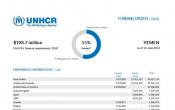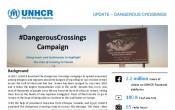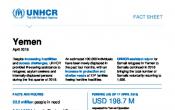Yemen
Operation: Yemen
Location
{"longitude":48,"latitude":16,"zoom_level":0,"iso_codes":"'YEM'"}
By clicking on the icons on the map, additional information is displayed.
Key Figures
| 2017 year-end results | |
| 366,900 | IDPs received CRI support |
| 215,300 | IDPs were reached by protection monitoring |
| 98,000 | medical consultations were provided for refugees and members of the host community |
| 4,100 | refugees received cash assistance |
| 800 | Somalis departed through an assisted spontaneous return |
| 91% | of primary-aged children in Kharaz camp were enrolled in schools |
| 2018 planning figures | |
| 610,000 | vulnerable IDPs/IDP returnees will receive cash grants for shelter and protection |
| 372,000 | IDPs/IDP returnees will receive core relief items |
| 23,000 | IDPs/IDP returnees will receive legal assistance |
| 50,000 | refugees willing to return to their country of origin will be supported with cash grants and protection counseling |
| 17,000 | of the most vulnerable refugees will receive cash grants |
| 14,000 | refugee children will be enrolled in primary education |
Latest Updates and Related Links
People of Concern
17%
Increase in
2016
2016
| 2016 | 3,278,011 |
| 2015 | 2,809,088 |
| 2014 | 686,217 |

[["Refugees",269783],["Asylum-seekers",9097],["IDPs",2025060],["Returned IDPs",974058],["Returned refugees",1],["Others of concern",12]]
Loading ...
Yemen
< Back
2017
{"categories":[2013,2014,2015,2016,2017,2018],"budget":[73.02036891,55.90237687,107.42361363,124.06305842,113.649647797,198.74363653],"expenditure":[45.55776942,32.43507863,59.1504741,76.2339041,70.06427451,null]}
{"categories":[2013,2014,2015,2016,2017,2018],"p1":[34.65978173,37.76781567,54.5338847,48.97075377,63.273753997,95.14566879],"p2":[null,null,null,null,null,null],"p3":[null,null,null,null,null,null],"p4":[38.36058718,18.1345612,52.88972893,75.09230465,50.3758938,103.59796774]}
{"categories":[2013,2014,2015,2016,2017,2018],"p1":[24.32612142,24.52485244,30.6292506,27.28466288,28.77866001,null],"p2":[null,null,null,null,null,null],"p3":[null,null,null,null,null,null],"p4":[21.231648,7.91022619,28.5212235,48.94924122,41.2856145,null]}
Loading ...
CHOOSE A YEAR
- 2014
- 2015
- 2016
- 2017
- 2018
Operational context
Yemen is experiencing a severe protection crisis. An escalation in hostilities in late 2017 resulted in new displacement, precluded safe return and increased demands on UNHCR’s emergency response capacity. Parties to the conflict have disregarded humanitarian principles, with the number of civilian deaths and injuries rising at an alarming rate. Conditions were further exacerbated by a blockade on the importation of critical goods, resulting in inflation, currency devaluation, and fuel scarcity that led to a dramatic increase in the cost of logistics, warehousing and distribution.Despite a constrained operational environment and limited funds, UNHCR and its partners continued to deliver assistance in the field to those who needed it the most.
Population trends
In 2017, Yemen was hosting some 271,000 refugees and close to 10,000 asylum-seekers, representing a slight increase from 2016.In 2017, an estimated 100,000 people arrived to Yemen from the Horn of Africa; a small percentage of whom sought international protection from UNHCR. This represents a slight decrease in new arrivals from 2016, but nevertheless a striking trend for a country so heavily impacted by war.
According to the Task Force on Population Movement, there were 2.1 million IDPs across 21 governorates, with 89 percent of IDPs displaced for over a year – representing protracted displacement. An escalation in conflict at the end of 2017 resulted in new displacement of some 30,000 people, with the expectation that this trend could continue in 2018. A greater number of IDPs were also resorting to sheltering in collective centres or spontaneous settlements. There were nearly 1 million IDP returnees across 20 governorates, with a lower proportion of returnees being able to return to their original homes than in 2016.
Key achievements
During 2017, UNHCR carried out 60 high-risk missions in addition to 360 missions to field locations all across Yemen.Due to deteriorating circumstances for people of concern, UNHCR adopted a revised cash assistance criteria, broadening the scope of inclusion and supporting more than 4,100 vulnerable refugees and close to 334,500 IDPs with financial assistance.
Protection monitoring was scaled up in collaboration with the Protection Cluster, with some 4,200 assessments carried out and more than 5,500 households reached in the south of country. Protection monitoring teams in the north reached close to 215,300 people. Some 17,200 IDPs received mental health and psychosocial services, reflecting the psychological toll of war on the population.
In total, UNHCR assisted over 800,000 IDPs in 2017 with protection services and humanitarian assistance across Yemen.
Unmet needs
Given the deterioration in the socio-economic situation, cash assistance became the only lifeline for many refugees. UNHCR revised its criteria to reach the most vulnerable, but funds remained insufficient.The absence and breakdown of national services placed enormous pressure on UNHCR to provide basic services as a substitute - vital to the preservation of protection space. Furthermore, greater funding was needed to provide specialized services for the growing and pressing needs of people with disabilities and those with psycho-social challenges.
There was an overwhelming need for more funds for cash assistance, given both the higher cost of living, and the fact that many IDPs have been in a situation of protracted or multiple displacement.
Working environment
The already fragile situation in Yemen has deteriorated dramatically since March 2015 and continued to intensify during 2016, with some 21.1 million people or 81 per cent of the population of Yemen in need of humanitarian assistance. The Inter-Agency Standing Committee (IASC) system-wide level-3 emergency response, declared in July 2015, remains in place. Over a year into the current conflict, the precarious humanitarian situation is compounded by a deteriorating national economy and the disruption of already limited basic services. The humanitarian response in Yemen is further constrained by limitations to movement and access to people in need of assistance. Despite conditions in Yemen not being conducive for asylum owing to the on-going war, Yemen continues to be a destination country for new arrivals from Somalia and a transit country for many asylum-seekers and migrants. UNHCR benefits from a strong collaboration with partners, refugee community leaders and with the General Bureau of Refugee Affairs (BRA) at national and local level.Key Priorities
In 2017, UNHCR in Yemen will:• Ensure critical protection interventions and service delivery for internally displaced people through initiatives such as protection monitoring and multi-sectoral assessments, psychosocial counselling, legal assistance and multipurpose cash grants;
• Continue to work together with the Yemeni authorities to improve the accuracy and credibility of data on refugees and asylum-seekers and their specific needs;
• Work together with key partners, such as IOM, to enhance the capacity and impact of a regional awareness-raising initiative on the risks of irregular migration;
• Support voluntary return for people for whom return and reintegration is appropriate;
• Maintain its coordination and leadership role in the Protection, Camp Coordination and Camp Management and Shelter/NFI clusters; and co-lead with IOM the Task Force on Population Movement.





